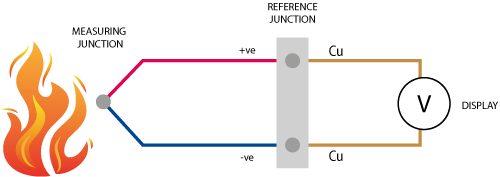How does a thermocouple work?

A thermocouple is a simple device that relies on the Seebeck effect which states that when you join two wires of dissimilar metals together at both ends and one of the ends is heated or cooled, then a current will flow in the circuit. If this thermoelectric circuit is then interrupted the open circuit voltage can be measured and will be proportional to the difference in temperature between the junctions. This effect is utilised to make the temperature sensor known as a thermocouple.
As mentioned above, the voltage generated is proportional to the temperature gradient across the two points which are known as the measuring junction, which is sometimes referred to as the 'hot' junction (which can be confusing if measuring temperatures below zero), and the reference junction as shown above. Different thermocouples types (K, T, J etc.) have different combinations of wires and so will have different characteristics such as output levels, stability, accuracy etc. and different temperature ranges.
For practical purposes the reference junction is referenced to 0ºC and so is usually referred as the 'cold' junction. When you connect a thermocouple to a thermocouple instrument, the circuitry in the instrument uses a temperature sensor (usually a thermistor) to measure the ambient temperature, which is then converted to the appropriate mV value for the thermocouple type and effectively added to the incoming signal in a process known as cold junction compensation.
The EMF output from all thermocouples is very small, typically mV with a change per ºC in the µV range. The change in EMF per ºC change in temperaure is known as the Seebeck coefficient and is shown in the table below: